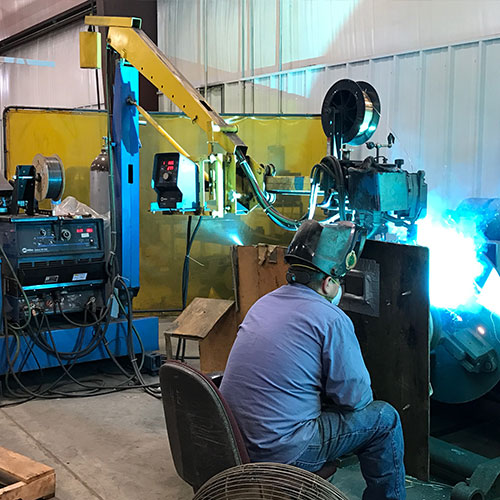Expert Welding Inspection Service for Structural Integrity
Expert Welding Inspection Service for Structural Integrity
Blog Article
Understanding the Numerous Sorts Of Welding Techniques and Providers Readily Available

Overview of Welding Techniques
Welding strategies incorporate a diverse variety of techniques used to join products together permanently. One common approach is arc welding, which includes creating an electrical arc in between an electrode and the base material to thaw and fuse them together. This technique is functional and can be utilized with numerous metals, making it one of one of the most commonly used welding procedures.

Additionally, TIG welding, or Gas Tungsten Arc Welding (GTAW), is a precise and clean welding technique that utilizes a non-consumable tungsten electrode to produce the weld. TIG welding is commonly used for thinner products and provides exceptional control over the welding procedure. On the whole, recognizing these numerous welding strategies is vital for choosing the most ideal technique for various tasks.
Frequently Utilized Welding Techniques
A range of typically utilized approaches are used in the field of welding to efficiently join products together. One of one of the most extensively utilized methods is Gas Steel Arc Welding (GMAW), likewise called MIG welding. This technique uses a wire electrode that is fed via a welding weapon, together with a protecting gas to safeguard the weld from contaminants airborne. One more common approach is Secured Metal Arc Welding (SMAW), or stick welding, which uses a flux-coated electrode to produce the weld. Tungsten Inert Gas (TIG) welding is preferred for its precision and flexibility, making use of a non-consumable tungsten electrode to create the weld. Flux-Cored Arc Welding (FCAW) is typically made use of in commercial settings due to its high welding rate and transportability. In Addition, Submerged Arc Welding (SAW) is suitable for developing deep welds on thick materials. These commonly made use of welding approaches deal with different needs and products, supplying options for different welding applications.
Advanced Welding Services
Building upon the foundation of typically used welding techniques, the world of advanced welding solutions includes cutting-edge methods and modern technologies that push the boundaries of precision and performance in product joining procedures. Advanced welding services usually involve specialized techniques such as laser welding, electron beam of light welding, and rubbing stir welding. Laser welding utilizes an extremely concentrated beam to specifically join metals with minimal heat-affected zones, making it suitable for intricate or delicate components. Electron light beam welding, on the other hand, employs a high-velocity electron beam to create deep weld penetrations in products like aerospace alloys or different metals. Friction mix welding, a solid-state signing up with procedure, enables the welding of materials that are challenging to fuse using conventional methods, like aluminum and copper. These advanced strategies supply boosted control over the welding process, resulting in stronger, extra durable welds with lowered distortion and improved total top quality.
Specialized Welding Methods

Another specialized welding strategy is laser beam of light welding, where a highly focused beam is utilized to join steels with very little heat-affected zones and distortion. This method is generally used in markets requiring high accuracy and sanitation, such as electronic devices and medical tool production. Furthermore, eruptive welding is an one-of-a-kind method that utilizes controlled nitroglycerins to bond dissimilar steels with each other, developing reliable and solid joints. These specialized welding strategies showcase the variety and innovation existing in the field of welding, supplying services for a vast array of industrial applications.

Selecting the Right Welding Refine
With different welding methods readily available, it is essential to consider variables such as the kind of metal, thickness, joint style, and desired end outcome when selecting the best welding procedure. Amongst the usual welding techniques are Gas Metal Arc Welding (GMAW), Secured Metal Arc Welding (SMAW), Gas Tungsten Arc Welding (GTAW), and Flux-Cored Arc Welding (FCAW) GMAW, likewise known as MIG welding, is appropriate for welding thin to thick steels and is flexible in different positions.
Verdict
To conclude, comprehending the various sorts of welding techniques and solutions offered is essential for picking the right technique for a specific task. By understanding the typically utilized welding techniques, advanced welding solutions, and specialized methods, people can make informed choices to make certain the success of their welding jobs. It is essential to think about variables such as materials, task demands, and budget when selecting one of the most suitable welding procedure.
From traditional approaches like stick welding to innovative procedures such visit homepage as laser welding, the world of welding provides a multitude of alternatives for signing up with metals together.In addition, TIG welding, or Gas Tungsten Arc Welding (GTAW), is a tidy and accurate welding technique that makes use of a non-consumable tungsten electrode to produce the weld. Advanced welding solutions typically involve specialized techniques such as laser welding, electron light beam welding, and rubbing stir welding. Amongst the typical welding approaches are Gas Steel Arc Welding (GMAW), Shielded Metal Arc Welding (SMAW), Gas Tungsten Arc Welding (GTAW), and Flux-Cored Arc Welding (FCAW) By being aware of the typically made use of welding methods, advanced welding solutions, and specialized strategies, people can make enlightened decisions to make certain the success of their welding projects.
Report this page